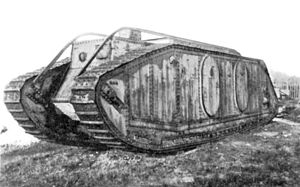Mark IX tank
| Mark IX | |
|---|---|

Mark IX
|
|
| Production history | |
| Designer | Lt. G.R. Rackham |
| Manufacturer | Marshall, Sons & Co. |
| No. built | 34 (total) |
| Specifications | |
| Weight | 27 t |
| Length | 9.7 m (31 ft 11 in) |
| Width | 2.5 m (8 ft 1 in) |
| Height | 2.64 m (8 ft 8 in) |
| Crew | 4: commander, driver, mechanic, machine gunner; up to 30 men could be carried. |
|
|
|
| Armour | 10 mm |
|
Main
armament |
2 x 0.303 in machine guns |
|
Secondary
armament |
none, but loopholes for 16 soldiers |
| Engine |
Ricardo 6-cylinder petrol 150 horsepower (110 kW) |
| Power/weight | 5.6 horsepower per tonne (4.2 kW/t) |
| Suspension | unsprung |
|
Operational
range |
20 miles (32 km) |
| Speed | 6.9 km/h (4.3 mph) |
The Mark IX tank was a British armoured fighting vehicle from the First World War. It was the world's first specialised armoured personnel carrier (APC).
During the first actions with tanks, it became clear that infantry often could not keep up with the tanks; not because soldiers were too slow—the early tanks themselves could only move at a walking pace—but because soldiers on foot remained vulnerable to machine gun fire, though tanks had been invented to solve that problem. On many occasions, positions gained at great cost were immediately lost for lack of infantry to consolidate. It was thought this problem might be solved by cramming a few infantry soldiers into each tank, but the atmosphere inside was of so poor quality that the soldiers became ill—losing consciousness or, when exposed to fresh air again, being incapacitated for about an hour while recovering from the noxious fumes inside the tank. They would be sick and suffer from severe headaches.
In the summer of 1917, at the same time as another 'carrier' tank, the Gun Carrier Mark I, was under development, Lieutenant G.R. Rackham was ordered to design an armoured vehicle specifically for troop transport. He cooperated with Eustace Tennyson d'Eyncourt, the chairman of the Landships Committee. Design was complicated by a demand that the vehicle could be fitted with sponsons, converting it into a more modern battle tank than the Mark V, in case the Mark VIII tank design proved a failure and the type was still designated as a tank, a 'Mark IX' to succeed the Mark VIII but that requirement was soon dropped due to its complexity.
In September 1917 Armstrong, Whitworth & Co. in Newcastle-upon-Tyne began constructing two prototypes of a pure transport vehicle that would become the Mark IX, which could also serve as a supply tank. The prototypes were approved the following year, at a time when it had become clear that a possible alternative, the stretched Mark V* tank, was unsuited for infantry transport. Two hundred Mark IXs were ordered from the tractor manufacturer Marshall, Sons & Co. of Gainsborough, Lincolnshire but by the end of the Great War only three had been finished, out of a total ultimate production run of thirty-four. A specially-designed sledge developed by the tank workshop in France, that allowed an additional 10 long tons (10 t) of stores to be hauled, was tried.
...
Wikipedia
